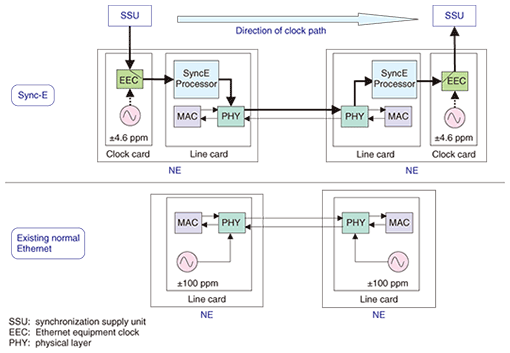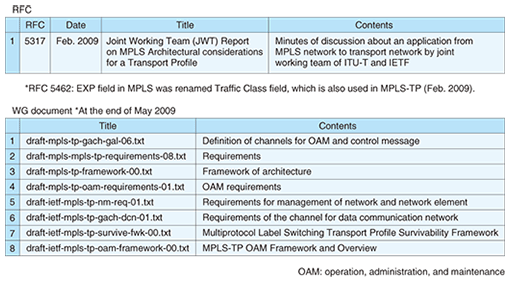 |
|||||
|
|
|||||
|
Global Standardization Activities Vol. 7, No. 7, pp. 19–23, July 2009. https://doi.org/10.53829/ntr200907gls Status of Packet Transport Network Standardization in ITU-TAbstractThis article introduces the current status of the standardization of carrier-grade packet transport technology in ITU-T (International Telecommunication Union, Telecommunication Standardization Sector) Study Group 15. With the recent trend for carrying all communications over Internet protocol networks, packet traffic is rapidly becoming the mainstream of data traffic. Packet-based maintenance and operation will become more important than before, even in the transport network.
1. Expectations for packet transport networkITU-T (International Telecommunication Union, Telecommunication Standardization Sector) Study Group 15 (SG15) has been standardizing transport technologies such as synchronous digital hierarchy (SDH) and the Optical Transport Network (OTN), which feature long-distance, high-bit-rate, and large-capacity transmission and can provide carrier-grade services. The following sections focus on standardization issues related to packet transport technologies. With the recent trend for carrying all types of communication over Internet protocol (IP) networks, or Ethernet, existing circuit-based networks like SDH and OTN occasionally accommodate client traffic inefficiently. As a result, packet technologies that can accommodate client data more efficiently and cost-effectively are expanding rapidly in carriers’ networks. However, when the packet network started to become widespread, most carriers initially faced some issues concerning fault location, fast switching in the event of a failure, and so on because of the lack of operation, administration, and maintenance functions. This is the background of how packet transport appeared. One of its most important characteristics is the implementation of SDH-like or OTN-like operation functions in the packet network. In packet transport, the route of packets between two network elements (NEs) is determined, and the connectivity of the path is basically and periodically monitored. This feature makes it possible for operators to manage the path condition. In some cases, this kind of feature is called connection oriented. Other important characteristics of the packet transport network are protection, which enables the quick recover of a particular path when that path develops a fault; alarm transfer, which promptly transmits information about faults to other NEs; and traffic engineering, which enables operators to flexibly assign path bandwidth. Moreover, packet transport technologies are also expected to provide guaranteed quality of service and extended scalability. As network facilities are getting older, migration to a new network that can accommodate existing services is one of the most serious issues. A typical example of migration from the old SDH network to the new packet transport network is shown in Fig. 1. The packet transport network efficiently accommodates new IP-oriented services and can retain the existing services if it takes over SDH-like maintenance and operation functions. This requires a circuit emulation service. Moreover, frequency distribution in the packet network is also a challenge: it is necessary to keep clock paths for network synchronization.
The requirements for a packet transport network can be categorized into two main topics: packet transfer technology and synchronization technology (Fig. 2), which are under development in ITU-T. For synchronization, discussion of time and phase distribution for future applications has started. Thus, expectations for packet transport networks are becoming higher and higher.
2. Packet transfer technologies for packet transport network2.1 OverviewThis section introduces three packet forwarding technologies related to packet transfer and synchronization technologies. (1) IP/multiprotocol label switching (IP/MPLS). This technology has been standardized by the Internet Engineering Task Force (IETF). MPLS is a label forwarding technology that encapsulates and transparently transmits packet data units such as ones for Ethernet, frame relay, and asynchronous transfer mode, as well as IP. Although IP/MPLS was initially a connectionless protocol, it was later enhanced and reclassified as a connection-oriented protocol. (2) Transport-MPLS (T-MPLS) of ITU-T. This technology is based on the label forwarding technology of MPLS. However, some MPLS functions are excluded or disabled, and carrier-grade performance is expected to be provided by adding a maintenance operation function. The name changed from T-MPLS to MPLS-Transport Profile (TP) and standardization is under development in cooperation with IETF. (3) Provider Backbone Bridge Traffic Engineering (PBB-TE) of the Institute of Electrical and Electronics Engineers (IEEE). This protocol uses MAC-in-MAC technology (MAC: media access control) and the transmission layer is independently defined and connection-oriented operation is achieved by point-to-point transit connection. The standard was scheduled to be completed as IEEE 802.3Qay in March 2009. ITU-T also agreed to make a recommendation for PBB-TE in June 2007. In ITU-T SG15, there are currently two standardization topics for the packet transport network: MPLS-TP and PBB-TE. However, MPLS-TP is being discussed more actively in ITU-T than PBB-TE. 2.2 MPLS-TP2.2.1 OverviewMPLS-TP can be regarded as a subset of MPLS in a sense. The meaning of “TP” encompasses the maintenance operation (service and operation) of existing transport networks (SDH, OTN, etc.) and this is the most essential feature. This section describes the differences between MPLS and MPLS-TP and explains the improvements to maintenance operations in MPLS-TP. First, MPLS does not satisfy the requirements in terms of maintenance operation level in the transport network although it does have maintenance operation tools for fault detection such as Virtual Circuit Connectivity Verification, Bidirectional Forwarding Detection, and LSP-Ping. For MPLS-TP, a new channel, Generic Associated Channel (G-ACH), is defined to improve the maintenance operation for the performance monitoring, protection, and management, etc. Second, MPLS has features such as Penultimate Hop Popping, Equal Cost Multi-Path, and label merging. However, if these functions are used, the management of a connection-oriented path between the two end points would be difficult because of the lack of traceability. Therefore, to improve maintenance, these functions are disabled in MPLS-TP. Third, in MPLS, all the paths are basically controlled by the control plane (part of the autonomous control) through a soft state procedure. (When there is a fault in the exchange of autonomous control messages about a specific path, that path is automatically disconnected.) Therefore, a fault in the control plane could have a negative impact on user traffic, even if there is no problem in the transport plane. In MPLS-TP, on the other hand, the maintenance operation features are improved because network operation including path management is under the responsibility of the management plane (which lets operators consciously and manually manage all the paths), which is specified as a clear requirement. Moreover, ASON (Automatically Switched Optical Network), standardized in ITU-T recommendation G.8080, can be applied to the control plane if network operators want to utilize it in a complementary manner. In ASON, a control plane fault never affects user traffic because the control plane is completely independent of the transport plane (which carries client data). As a result, even when the control plane is deployed, MPLS-TP can provide high reliability, which is one of the major characteristics of the transport network. IETF is now developing MPLS-TP-related Requests for Comments (RFCs) that specify MPLS-TP requirements and so on. Therefore, the above requirements have not yet received final approval. 2.2.2. Standardization historyDiscussion of the migration from the time division multiplexing network to the packet transport network has intensified since about 2000. ITU-T started producing drafts under the name T-MPLS (Transport MPLS) in May 2005. However, since there was no adequate discussion of the interoperability of T-MPLS in ITU-T and MPLS in IETF, representatives of these two groups met in September 2007 and decided to form a joint working team (JWT) to continue discussions. Afterwards, progress on making T-MPLS-related recommendations stopped temporarily in February 2008 and a technical study was jointly performed by both groups. As a result, they reached an agreement that T-MPLS could be accomplished by enhancing the existing MPLS and PWE3 (pseudowire emulation edge to edge) and that they would continue collaborating with each other to develop the standardization. It was agreed to clarify the difference from T-MPLS that had been made before both groups agreed that the new name “MPLS-TP” would be used instead of T-MPLS from December 2008 onwards. Following the MPLS-TP-related RFCs, a series of revised MPLS-TP recommendations are scheduled to receive consent in ITU-T in October 2009 and May 2010. 3. Synchronization in packet transport networkIn response to requests from some legacy carriers for a clock path and circuit emulation service, ITU-T began standardization of Synchronous Ethernet (Sync-E), which is compared with the existing ordinary Ethernet in Fig. 3. Sync-E uses the same technology as is used for the clock in SDH and it distributes frequency using the physical layer of Ethernet to achieve the clock path. Even if the synchronous high-quality network clock signal delivered by the synchronization supply unit in the synchronization network is disconnected, an NE can provide a higher-quality clock (±4.6 ppm) than the existing Ethernet (±100 ppm).
ITU-T Recommendation G.8261 (Timing and Synchronization Aspects in Packet Networks) provides an architecture and presents Sync-E requirements, and G.8262 (Timing characteristics of Synchronous Ethernet equipment slave clock) specifies clock requirements. Moreover, Synchronous Status Message, which is mainly used to report the quality level of the transmitting clock to other NEs, is specified by G.8264 (Distribution of timing through packet networks). A series of recommendations related to Sync-E were completed in 2008, so Sync-E is expected to be widely used in commercial networks in the near future. 4. Future activitiesIETF is developing related RFC drafts that specify MPLS-TP-related requirements, the architectural framework, and so on (Table 1). On the other hand, ITU-T plans to give consent to a revision of existing T-MPLS-related recommendations where the new name MPLS-TP is used and all the standards are basically based on related RFCs in IETF. Since there is little time before ITU-T’s scheduled consent dates (October 2009 and May 2010), IETF and ITU-T need to collaborate closely as much as possible.
Reference
|
|||||













